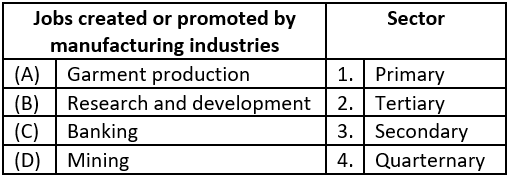Case Study Question 01
Read the source given below and answer the following questions:
Globalisation has been facilitated by several factors. Three of these have been highlighted: rapid improvements in technology, liberalisation of trade and investment policies and, pressures from international organisations such as the WTO. But with the development of an economy, environmental protection is also necessary. In June 1992, more than 100 heads of states met in Rio-de-Janeiro in Brazil, for the first international Earth Summit. The summit was convened for addressing urgent problems of environmental protection and socio-economic development at the global level. The assembled leaders signed the Declaration on Global Climatic Change and Biological Diversity. The Rio Convention endorsed the global Forest Principles and adopted Agenda 21 for achieving Sustainable Development in the 21st century.
Answer the following MCQs by choosing the most appropriate option :
Question.1. The so called first international Earth summit was convened for
(a) addressing urgent problems of environmental protection.
(b) addressing socio-economic development at the global level.
(c) both (a) and (b)
(d) none of these
Question.2. The passage is mainly related to
(a) Globalisation and environment
(b) Rio-de-Janeiro Earth Summit 1992
(c) Sustainable development
(d) Agenda 21
Question.3. Agenda 21 is the flowchart of action to be taken by the assembled nations to
(a) achieve environmental protection.
(b) fulfil the needs of future generations.
(c) combat the hurdles that debar sustainable development.
(d) attain socio-economic development at global level.
Question.4. The term used to achieve development without damaging the environment and without compromising with the needs of the future generations is
(a) Socio-economic development
(b) Agenda 21
(c) Global environmental development
(d) Sustainable development
Ans.1. (c)
Ans.2. (a)
Ans.3. (c)
Ans.4. (d)
Case Study Question 02
Read the source given below and answer the following questions:
Getting a loan from bank is much more difficult than taking loan from informal sources. Absence of collateral security and documentation prevents the poors from getting bank loans. Self Help Group is a group of people usually belonging to one neighbourhood having same social and economic backgrounds. They meet and save money regularly as per their ability. Members of the group can take small loans from the group itself to meet their needs. The group charges interest less than moneylenders on these loans. After one or two years, if the group is regular in savings, it becomes eligible for availing loan from the bank. Loan is sanctioned in the name of group and is meant to create self employment opportunities.
Answer the following MCQs by choosing the most appropriate option:
Question.1. What is the most essential requirement for taking loan from information services?
(a) Collateral security
(b) Bribe
(c) Source from a top officer
(d) None of these
Question.2. SHG is a group of people usually belonging to
(a) the same caste
(b) nearby villages
(c) one neighbourhood having same social and economic backgrounds
(d) different villages
Question.3. What facilities do the members have who are in the same group?
(a) They are not given any facility.
(b) They can take small loans from the group itself to meet their needs.
(c) They are debarred from the group.
(d) No facility is given to them.
Question.4. What benefits are there for a SHG that is regular in savings?
(a) The dispute arise after sometimes.
(b) They are rewarded by the government.
(c) They get jobs in government departments.
(d) They are entitled to raise loan from bank in the name of SHG.
Ans.1. (a)
Ans.2. (c)
Ans.3. (b)
Ans.4. (d)
Case Study Question 03
Read the source given below and answer the following questions:
Ever since humans appeared on the earth, they have used different means of communication. But, the pace of change, has been rapid in modern times. Long-distance communication is far easier without the physical movement of the communicator or receiver. Personal communication and mass communication including television, radio, press, films, etc. are the major means of communication in the country.
Mass communication provides entertainment and creates awareness among people about various national programmes and policies. It includes radio, television, newspapers, magazines, books and films. All India Radio (Akashwani) broadcasts a variety of programmes in national, regional and local languages for various categories of people, spread over different parts of the country. Doordarshan, the national television channel of India, is one of the largest terrestrial networks in the world. It broadcasts a variety of programmes from entertainment, educational to sports, etc. for people of different age groups.
India publishes a large number of newspapers and periodicals annually. They are of different types depending upon their periodicity. Newspapers are published in about 100 languages and dialects. India is the largest producer of feature films in the world. It produces short films; video feature films and video short films. The Central Board of Film Certification is the authority to certify both Indian and foreign films.
Answer the following MCQs by choosing the most appropriate option:
Question.1. What does AIR stand for?
(a) All India Radio
(c) Asian Indo Radio
(b) American Indian Radio
(d) None of these
Question.2. Which is the authority to certify both Indian and foreign films?
(a) Censorship Board
(b) Central Board of Film Certification
(c) Central Bureau of Certification
(d) Central Board
Question.3. Following are the features of mass communication, except:
(a) Mass communication includes television, radio, press, films, etc.
(b) It is one of the major means of communication in the country.
(c) It provides entertainment as well as creates awareness among the masses.
(d) It is a communication between person to person.
Question.4. Which is the largest terrestrial networks in the world?
(a) BBC
(b) CNN
(c) Doordarshan
(d) Reuters
Ans.1. (a)
Ans.2. (b)
Ans.3. (d)
Ans.4. (d)
Case Study Question 04
Read the source given below and answer the following questions:
In recent years, the central and state governments in India are taking special steps to attract foreign companies to invest in India. Industrial zones, are called Special Economic Zones (SEZS), are being set up. SEZs are to have world class facilities: electricity, water, roads, transport, storage, recreational and educational facilities. Companies who set up production units in the SEZs do not have to pay taxes for an initial period of five years. Government has also allowed flexibility in the labour laws to attract foreign investment. Companies in the organised sector have to obey certain rules that aim to protect the workers’ rights. In the recent years, the government has allowed companies to ignore many of these. Instead of hiring workers on a regular basis, companies hire workers ‘flexibly’ for short periods when there is intense pressure of work. This is done to reduce the cost of labour for the company. However, still not satisfied, foreign companies are demanding more flexibility in labour laws.
Answer the following MCQs by choosing the most appropriate option:
Question.1. What do you understand by the term ‘Special Economic Zones’?
(a) Industrial zones
(b) Banking zone
(c) Farming zone
(d) Forest Conservation zone
Question.2. Which of the following steps have been taken by the government to attract foreign companies?
(a) Providing food, shelter and cloth
(b) Judicial facilities
(c) Companies do not have to pay taxes for an initial period of five years. Government has also allowed flexibility in the labour laws to attract foreign investment.
(d) All of these
Question.3. Which facilities are provided in Special Economic Zones?
(a) Free raw materials for industries
(b) Voting facility
(c) SEZs are to have world class facilities: electricity, water, roads, transport, storage, recreational and educational facilities.
(d) Zero taxes in 10 years
Question.4. Which of the following are/is the demands of foreign companies?
(a) Free electricity
(b) Free transport
(c) Less flexibility in labour laws
(d) Foreign companies are demanding more flexibility in labour laws.
Ans.1. (a)
Ans.2. (c)
Ans.3. (c)
Ans.4. (d)
Case Study Question 05
Read the source given below and answer the following questions:
Swapna, a small farmer, grows groundnut on her three acres of land. She takes a loan from the moneylender to meet the expenses of cultivation, hoping that her harvest would help repay the loan. Midway through the season the crop is hit by pests and the crop fails. Though Swapna sprays her crops with expensive pesticides, it makes little difference. She is unable to repay the moneylender and the debt grows over the year into a large amount. Next year, Swapna takes a fresh loan for cultivation. It is a normal crop this year. But the earnings are not enough to cover the old loan. She is caught in debt. She has to sell a part of the land to pay off the debt.
Answer the following MCQS by choosing the most appropriate option:
Question.1. The passage given above relates to which of the following options
(a) Collateral Credit
(b) Credit recovery is very painful
(c) Failure of Crops
(d) Credit is somewhere beneficial
Question.2. According to the passage Swapna faced which of the following options:
(a) The crop is hit by pests and the crop fails.
(b) She had to sell a part of the land to pay off the debt.
(c) Credit left her worse off.
(d) All of these.
Question.3. It refers to an agreement in which the lender supplies the borrower with money, goods or services in return for the promise of future payment
(a) Terms and Credit
(b) Credit
(c) Depositor
(d) Borrower
Question.4. The above passage is an example of
(a) Collateral
(b) Debt Trap
(c) Credit plays a vital and positive role
(d) None of these
Ans.1. (a)
Ans.2. (d)
Ans.3. (a)
Ans.4. (b)
Case Study Question 06
Read the text given below and answer the following questions.
Manufacturing industries not only help in modernising agriculture, which forms the backbone of our economy, they also reduce the heavy dependence of people on agricultural income by providing them jobs in secondary and tertiary sectors. Industrial development is a precondition for eradication of unemployment and poverty from our country. This was the main philosophy behind public sector industries and joint sector ventures in India. It was also aimed at bringing down regional disparities by establishing industries in tribal and backward areas. Export of manufactured goods expands trade and commerce, and brings in much needed foreign exchange. Countries that transform their raw materials into a wide variety of finished goods of higher value are prosperous. India’s prosperity lies in increasing and diversifying its manufacturing industries as quickly as possible. Agriculture and industry are not exclusive of each other. They move hand in hand. For instance, the agro-industries in India have given a major boost to agriculture by raising its productivity.
Answer the following MCQs by choosing the most appropriate option:
Question.1. Manufacturing industries fall in _________and agriculture in
(a) primary, secondary sector
(c) primary, tertiary sector
(b) secondary, tertiary sector
(d) secondary, primary sector
Question.2. Manufacturing provides job opportunities to reduce dependance on agriculture. Identify which sector the following jobs belong to?
(a) A-1, B-2, C-3, D-4
(b) A-3, B-4, C-2, D-1
(c) A-2, B-3, C-1, D-2
(d) A-4, B-1, C-4, D-3
Question.3. Which of the following options does not help in modernising agriculture?
(a) Manufacturing farm equipment
(b) Providing unskilled labour force
(c) Supplying fertilizers and pesticides
(d) Producing tube well pumps and sprinklers
Question.4. In order to attract foreign manufacturing firms, a country needs to develop
(a) agrarian facilities
(b) cultivable lands
(c) media facilities
(d) infrastructure facilities
Ans.1. (d)
Ans.2. (b)
Ans.3. (b)
Ans.4. (d)




